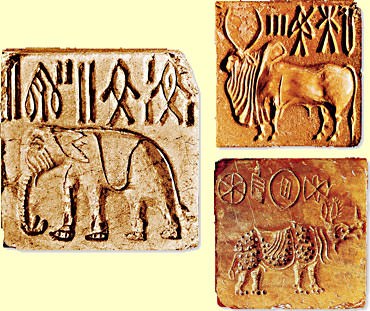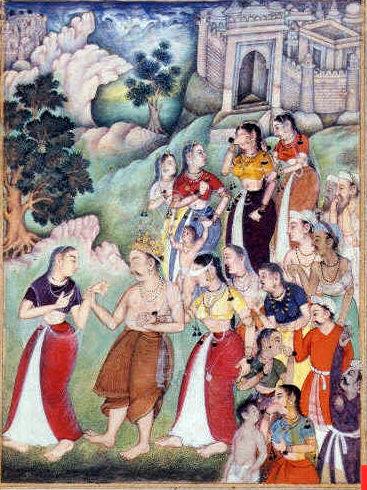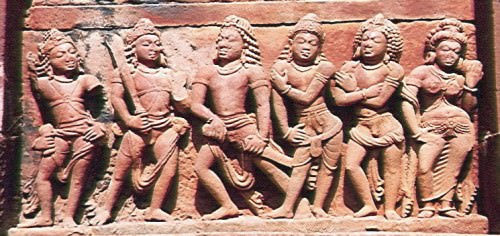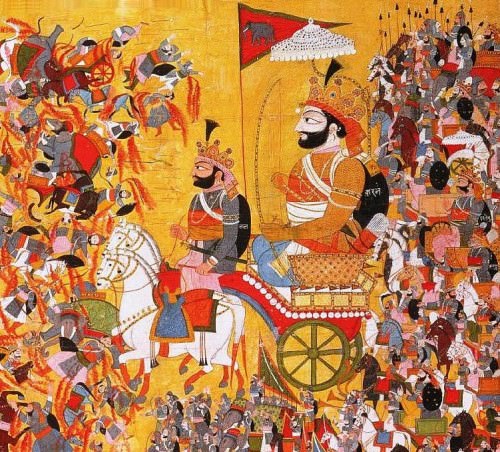Indus Valley Civilization › Kauravas » Ancient origins
Articles and Definitions › Contents
- Indus Valley Civilization › Antique Origins
- Kauravas › Ancient History
Ancient civilizations › Historical and archaeological sites
Indus Valley Civilization › Antique Origins
Definition and Origins

The Indus Valley Civilization was an ancient civilization located in what is Pakistan and northwest India today, on the fertile flood plain of the Indus River and its vicinity. Evidence of religious practices in this area date back approximately to 5500 BCE.Farming settlements began around 4000 BCE and around 3000 BCE there appeared the first signs of urbanization. By 2600 BCE, dozens of towns and cities had been established, and between 2500 and 2000 BCE the Indus Valley Civilization was at its peak.
THE LIFE OF THE INDUS VALLEY CIVILIZATION
Two cities, in particular, have been excavated at the sites of Mohenjo-Daro on the lower Indus, and at Harappa, further upstream. The evidence suggests they had a highly developed city life; many houses had wells and bathrooms as well as an elaborate underground drainage system. The social conditions of the citizens were comparable to those in Sumeria and superior to the contemporary Babylonians and Egyptians. These cities display a well-planned urbanization system.
THE EVIDENCE SUGGESTS THEY HAD A HIGHLY DEVELOPED CITY LIFE; MANY HOUSES HAD WELLS AND BATHROOMS AS WELL AS AN ELABORATE UNDERGROUND DRAINAGE SYSTEM.
There is evidence of some level of contact between the Indus Valley Civilization and the Near East. Commercial, religious, and artistic connections have been recorded in Sumerian documents, where the Indus valley people are referred to as Meluhhaites and the Indus valley is called Meluhha. The following account has been dated to about 2000 BCE: "The Meluhhaites, the men of the black land, bring to Naram-Sin of Agade all kind of exotic wares." (Haywood, p. 76, The Curse of Agade)
The Indus Civilization had a writing system which today still remains a mystery: all attempts to decipher it have failed. This is one of the reasons why the Indus Valley Civilization is one of the least known of the important early civilizations of antiquity.Examples of this writing system have been found in pottery, amulets, carved stamp seals, and even in weights and coppertablets.
Another point of debate is the nature of the relationship between these cities. Whether they were independent city-states or part of a larger kingdom is not entirely clear. Because the writing of the Indus people remains undeciphered and neither sculptures of rulers nor depictions of battles and military campaigns have been found, evidence pointing in either direction is not conclusive.
DECLINE OF THE INDUS VALLEY CIVILIZATION
By 1800 BCE, the Indus Valley Civilization saw the beginning of their decline: Writing started to disappear, standardized weights and measures used for trade and taxation purposes fell out of use, the connection with the Near East was interrupted, and some cities were gradually abandoned. The reasons for this decline are not entirely clear, but it is believed that the drying up of the Saraswati River, a process which had begun around 1900 BCE, was the main cause. Other experts speak of a great flood in the area. Either event would have had catastrophic effects on agricultural activity, making the economy no longer sustainable and breaking the civic order of the cities.

Indus Valley Seals
Around 1500 BCE, a large group of nomadic cattle-herders, the Aryans, migrated into the region from central Asia. The Aryans crossed the Hindu Kush mountains and came in contact with the Indus Valley Civilization. This was a large migration and used to be seen as an invasion, which was thought to be the reason for the collapse of the Indus Valley Civilization, but this hypothesis is not unanimously accepted today.
Thus, the Indus Valley Civilization came to an end. Over the course of several centuries, the Aryans gradually settled down and took up agriculture. The language brought by the Aryans gained supremacy over the local languages: the origin of the most widely spoken languages today in south Asia goes back to the Aryans, who introduced the Indo-European languagesinto the Indian subcontinent. Other features of modern Indian society, such as religious practices and caste division, can also be traced back to the times of the Aryan migrations. Many pre-Aryan customs still survive in India today. Evidence supporting this claim includes: the continuity of pre-Aryan traditions; practices by many sectors of Indian society; and also the possibility that some major gods of the Hindu pantheon actually originated during the time of the Indus Valley Civilization and were kept "alive" by the original inhabitants through the centuries.
Kauravas › Ancient History
Definition and Origins

The Kauravas are the 100 sons of the King of Hastinapur, Dhritarashtra, and his wife Gandhari who played a significant role in the legendary Indian epic, the Mahabharata. Hastinapur is assumed to be the current modern state of Haryana, and Gandhar, to where Gandhari belonged, is assumed to be the current city of Kandahar in Afghanistan. In the Mahabharata, the actions and behaviour of the Kauravas and their rivals, the Pandavas, changed the course of history following the Kurukshetra War.The traditional timeline of the Kauravas is similar to those of the Pandavas, beginning from 3229 BCE to about 3138 BCE. The life story of the Kauravas is of significance in India and in Hinduism, as their conduct often gives birth to numerous interpretations about unethical and immoral indulgence and their consequences.
The name Kaurava comes from the lineage of Dhritarashtra's ancestor Kuru, a dynamic king and ruler of the earth to all its corners, hence the heirs of the Kuru lineage termed as Kauravas, which for instance, also includes the five Pandavas and the later discovered sixth Pandava, Karna. Since Pandu could not continue to remain the king of Hastinapur due to a curse, Dhritarashtra, his cousin-brother was made the king. Pandu's five sons chose to be called Pandava and not Kaurava.Dhritarashtra was blind from birth while Gandhari being a women of strong conviction and wanting to suffer her husband's share of blindness, covered her eyes by tying a silk robe when she married him which she would only open at her death. In addition to the 100 Kauravas, Dhritarashtra and Gandhari were also blessed with a single daughter called Dussala.
BIRTH OF THE KAURAVAS
The famed rishi (sage), Dwaipayana, of dark complexion and incomparable merit, once happened to stop by at Hastinapur.Gandhari looked after his comforts and requirements, at which Dwaipayana was impressed and offered her a boon. The boons given by rishi's of divine merit never fail to come to fruition. He gave a boon to Gandhari that she would be blessed with 100 sons equal in might to her lord and accomplishments. Surprisingly, at the same time, Kunti, wife of Pandu, was also pregnant and soon gave birth to their first son, Yudhistira, before Gandhari could. To everyone's sad surprise, Gandhari's pregnancy went on for two years without any sign of delivery. Hearing of the birth of five divine looking sons of Kunti, Gandhari became furious with her condition and hit her abdomen hard. Soon after, she delivered not even one son, but a hard lump of mass which horrified everyone.
THE SAGE DWAIPAYANA GAVE A BOON TO GANDHARI THAT SHE WOULD BE BLESSED WITH 100 SONS, THE KAURAVAS.
The urgency of giving birth to sons was hidden in the reason that whoever, of Kunti and Gandhari, gives birth to sons first, would probably be favoured for the Hastinapur throne in their succession plan. Gandhari went to Dwaipayana and complained about the lump of mass, and doubted the rishi's boon, to which Dwaipayana affirmed he had never spoken a lie even in jest.He then asked Gandhari to cut the lump of mass into 100 pieces and place it in 100 different pots filled with clarified butter and wait. On Gandhari's request of a daughter, the pieces were cut into 101. The boon finally fructified and the first Kaurava, Duryodhana, was born followed by his 99 brothers, of which Dushasana became his favourite, and daughter Dussala.Duryodhana's name means 'unconquerable', and when he was born several animals howled which was seen as a bad omen by Vidura, who advised Dhritarashtra to abandon this child but he did not. This decision would shape their future.

Gandhari & Dhritarashtra
DEVELOPMENT OF THE KAURAVAS
The 100 Kauravas were brought up with overflowing love and care, especially from Dhritarashtra, but from their childhood they developed a dislike for the Pandavas, especially regarding the throne of Hastinapur. They all received their warfare training from Guru Drona, who also taught the Pandavas. Duryodhana was fortunate to learn mace fighting from Balarama, elder brother of Lord Krishna, who also taught the same to Bhima. They both turned out to be the best students of Balarama.Duryodhana was far too ambitious and greedy, and his maternal uncle Shakuni, brother of Gandhari, kept on feeding Duryodhana's narcissistic pride. Shakuni had pledged making his nephew Duryodhana the king of Hastinapur, due to his hatred toward Bhishma arising from an earlier conflict between the two kingdoms. Shakuni was to effect this by misleading the Pandavas, who were favourites among all, including Bhishma, the son of Ganga (The personification of the River Ganges in the Himalayas). Bhishma was the grand uncle of the Pandavas and Kauravas who favoured the Pandavas (read Yudhistira) to rule because of their merit, skills, knowledge, and righteous conduct – most essential for becoming a king – whereas the Kauravas (read Duryodhana), being falsely guided from childhood by Shakuni, were disqualified as unworthy to rule Hastinapur.
RIVALRY WITH THE PANDAVAS
This rivalry with Pandavas was inbred in the Kauravas but the Pandavas were cordial, and Yudhistira, being the most righteous, always offered to settle the conflict through dialogue and also agreed to take less, if ever there was a partition to come. That said, the Kauravas were notorious for nurturing a desire to kill the Pandavas. They, through their unrighteous but cunning conduct along with the help of Shakuni, were able to send the Pandavas into exile for 13 years.

Pandavas
For a sacrificial event, the Pandavas were sent to a newly built palace where they were to stay and accomplish their ritual fulfilment. Duryodhana purposely built the palace of lacquer and intended to burn the Pandavas and their mother Kunti while they slept at night. This plan failed as the Pandavas being skilled and brave, found a way underneath the earth and with their strength and power they escaped through a tunnel. However, they decided to remain unknown to the world and let the news of their supposed death in the fire stand undisputed.
Duryodhana eventually found out that the Pandavas were alive during the archery competition organised by Drupada to find a suitable match for his daughter Draupadi. Arjuna won the competition, since he was the only one who could complete the task apart from his friend Karna. It was later decided that the Pandavas would keep a barren, often considered cursed land, to be their new kingdom and settle the throne dispute. The Pandavas went on to build a magnificent palace, even grander than Hastinapur, with the help of the gods Vishwakarma and Indra, and was named as Indraprastha. Indraprastha is assumed to be located where the present city of New Delhi stands. Duryodhana could not stomach the endless prosperity of the Pandavas. Such was their fame that common citizens of Hastinapur wanted to resettle in Indraprastha. Duryodhana was insulted during Yudhistira's Indraprastha coronation ceremony, so he pledged to take revenge against the Pandavas, especially Draupadi, who laughed when Duryodhana fell down unknowingly in a pond disguised as a hard floor in the magical palace.

Draupadi Humiliated, Mahabharata
Duryodhana invited the Pandavas to a game of dice and was able to win everything owned by them, with the help of Shakuni.Yudhistira, after selling himself and all his four brothers had Draupadi offer herself in the game and so lost her too. Dushasana started undresing Draupadi, since she was now a servant of Duryodhana, right in the middle of the court full of righteous and unrighteous kings. Being requested by Bhishma and others, Dhritarashtra did not order Duryodhana to stop the drama, mainly due to his ignorance and excess love for his children. Lord Krishna magically saved Draupadi by making her saree unending and Dushasana fainted since her saree became infinite in length. At this every moment, the Pandavas were sentenced to exile for 12 years with one additional year of hidden exile, and this would again continue for 13 more years on top if anyone of the Pandavas or Draupadi were identified during the last year of exile. This tricky exile imposition was planned by Duryodhana and Shakuni to keep the Pandavas revolving in unending exile.
When the exile was announced, Bhima, the second Pandava, in a fierce ecstasy of wrath vowed to kill all the 100 sons of Dhritarashtra and to drink Dushasana's blood from his chest after thrashing him and wash Draupadi's untied hair with that blood. The Kauravas were fearful at this vow because they knew the strength of Bhima who was assuredly matchless by the Kauravas, except Duryodhana. Vikarna, the third Kaurava, the only one following righteousness, questioned the disrobing of Draupadi, and also made a remark about the doom of the Kuru lineage if it was not possible to protect their sister-in-law.
THE KURUKSHETRA WAR
Duryodhana with all his armies and reach could not discover the Pandavas in their 13 th year of exile, since they lived with concealed identities in the kingdom of Virata. The exile ended with the starting of the great Kurukshetra War which shaped history. Duryodhana took to war with unwavering confidence only because of Bhishma, Karna, and Guru Drona taking his side in the conflict, primarily due to the kingdom 's rules which compelled them, for they were righteous and followers of Dharma.

Karna in the Kurukshetra War
Bhima was fierce in killing the Kauravas and he killed 98 of them easily, with Dushasana and Duryodhana remaining.Dushasana was killed as per Bhima's pledge and he ended up drinking a small amount of blood from his chest, a scene which demoralised Duryodhana and Shakuni but he soon reaffirmed his stand in the war. Vikarna was the only Kaurava on whose death, Bhima lamented and cried since he was a just warrior but fought for Duryodhana only to fulfil his duty. Duryodhana was full of excess pride and heightened confidence in all his unrighteous acts since his only goal was to kill the Pandavas by any means and snatch the throne of Hastinapur. Had he become the king, the lineage would be full of immoral and unethical kings and the consequences would have been devastating. Lord Krishna sensing this, managed to help the Pandavas in winning the war. When Duyodhana alone was left as a warrior, his mother Gandhari asked him to come naked and she would open her silk robe for the first time after decades and shield Duryodhana by sending divine energy from her eyesight making him undefeatable and invincible. Lord Krishna being even more resourceful and shamed Duryodhana when he was walking naked after bathing in the sea to see his mother, which made Duryodhana wear a large leaf robe around his waist. Gandhari opened her eyes and sent all her divine energy, not knowing that Duryodhana was wearing a robe making that portion bereft of the power of invincibility.
The fight between Duryodhana and Bhima, who were both great mace fighters, was upfront and aggressive, where both showed all their skills in warfare. Duryodhana seemed to be undefeatable and Bhima was losing. Krishna then hinted to Bhima to hit him on the waist where he was weak, though hitting below the waist was a breach of the rule of war, but since it was to end the lawlessness of Duryodhana and his lineage, it was necessary to kill him by twisting the rules. Duryodhana was killed and the Pandavas ruled Hastinapur for 35 years before they renounced everything to return to the woods and retire.
Since Kuru, the ancestor of the Hastinapur kingdom, had a boon that anyone of their heirs dying on their land would always reach heaven irrespective of their deeds, the Kauravas after their death were settled in heaven with their ancestors.
LICENSE:
Article based on information obtained from these sources:with permission from the Website Ancient History Encyclopedia
Content is available under License Creative Commons: Attribution-NonCommercial-ShareAlike 3.0 Unported. CC-BY-NC-SA License